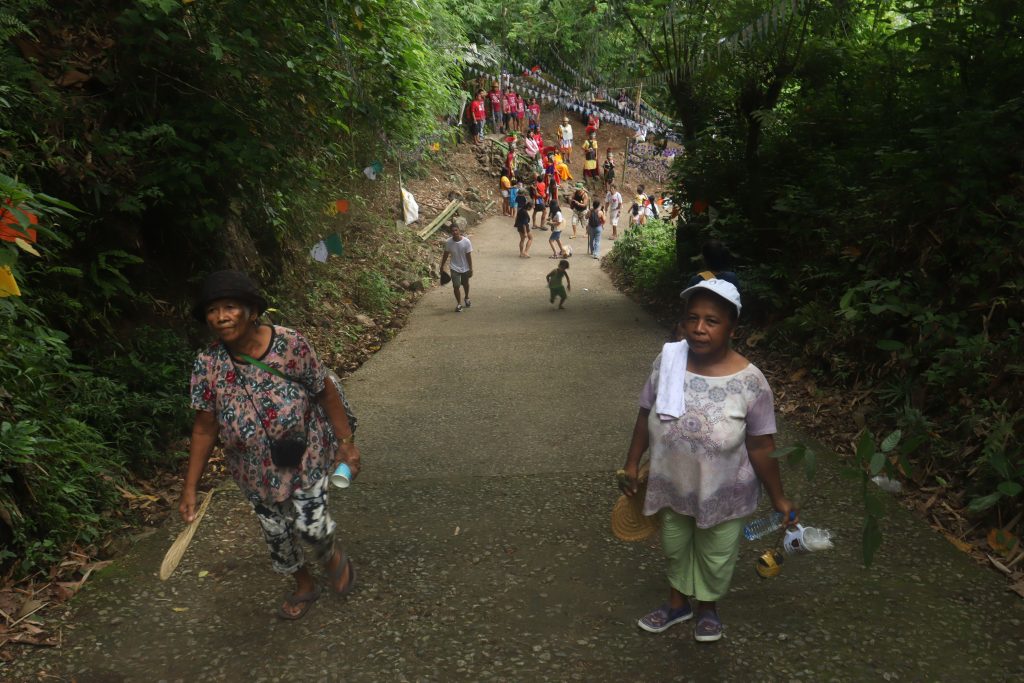The hike is tough and punishing but 72-year-old Lita Antazo still finds the muscle to climb Mount Ping-as in Pakil town in the northern Philippine province of Laguna.
Along with a multitude of Catholic devotees, she walked for hours to reach the hilltop where the annual pilgrimage known as “Ahunan sa Ping-as” (Climb in Ping-as) is observed.
Antazo said the climb is part of her “devotion to demonstrate faith and commitment, and a way of seeking God’s grace”.
The “Ahunan sa Ping-as” is a centuries-old religious practice involving an arduous trek to the Sierra Madre mountain range, pausing for prayers at the 14 stations, also called “kubol” (shed).

Devotees gather in a chapel on the top of the hill to celebrate the Holy Eucharist, which is followed by the ceremonial “pingasan” (tear), where devotees take a piece of the wooden cross for them to keep as a sacred souvenir.
Nelia de Leon, a quinquagenarian, has been climbing Mount Ping-as since the 1990s. She said she joins the pilgrimage to express her gratitude “for healing my asthmatic child with special needs”.
“My child has recovered from illness. He is now 25 years old. Since then, my family and I vowed to climb this mountain every year to give thanks,” she said.
This year, however, De Leon’s prayer is not only for the health and wellness of her family. Now, she included prayers for the protection of the environment and Mount Ping-as against a proposed dam project.
“We climb Mount Ping-as to pray for healing and forgiveness. Also, we make this small sacrifice of a tough hike to pray for an improved way of life, and for the safety of our people from human-induced and natural disasters,” she said.
On July 1, residents, church people, and various pro-environment organizations gathered in an ecumenical forum at the St. Peter of Alcantara Parish to discuss the impacts of the proposed Belisama Hydropower Projects on the environment.
“Now is the time to oppose and unite to prevent the construction of the gigantic Ahunan and Belisama dams and protect the Sierra Madre mountains,” said Teresa Saldaña Sanchez, ad hoc point person of Mamamayang Nagmamahal sa Pakil (Manapak).
The groups said the entire town may be submerged to flood due to the construction of the Ahunan Dam with a total load of 13.6 million cubic meters of water. They said the projects will also destroy the ecology of Mount Ping-as because the dam will stop the natural flow of water.
De Leon and Antao reached the mountaintop after nearly two hours. Ping-as prayer ground is filled with festive air once again after two years of hiatus due to the pandemic.
Only this time, shades of prevailing tensions are noticeable. There are anti-dam banners hanging on every tree and devotees wear “No to Dam” shirts. There is an apparent social rift among pro- and anti-dam attendees.
Nora Macapanpan of Manapak said, “We used to celebrate mass together. This time, people who oppose the project flock together. The same goes for pro-dam residents,” she said.
Beyond the project’s environmental impact, Manapak denounced the proponent’s use of “Ahunan” in naming the hydropower plant. The group said the use of “Ahunan” for the project name is a disrespect to their treasured religious tradition.
“The word Ahunan is sacred in Pakil,” said Lina Naldo, another Manapak member. She said the word is not just a verb but it also refers to a “sacred place”.
For the devotees, another Ahunan has passed but the struggle for the protection of the environment will never cease until the proposed projects, which threaten a place of worship and devotion, are scrapped and abandoned.